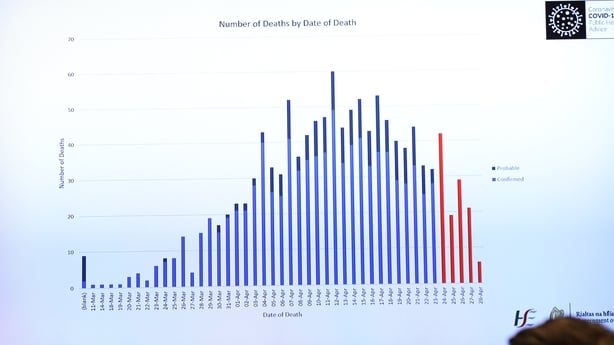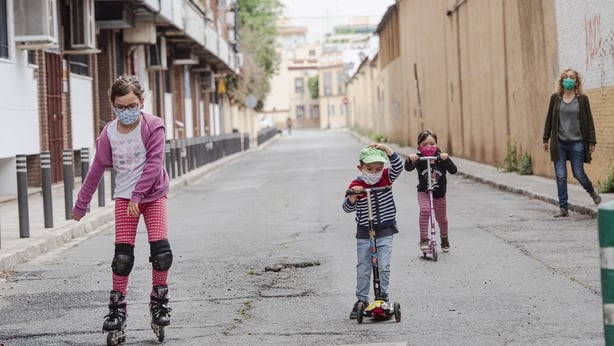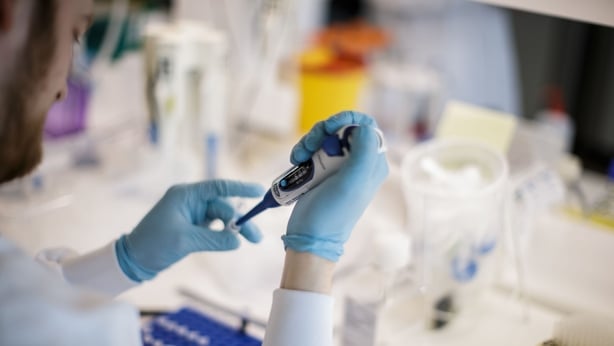Our Covid-19 restrictions, which have been in place since 28 March and extended in mid-April, are expected to be extended again past their current expiry date next Tuesday.
The ongoing limitations on work and movement are to be examined by the National Public Health Emergency Team on Friday, ahead of a Cabinet meeting later that day.
It is understood there are mixed views within Cabinet around easing restrictions on 5 May, while the Taoiseach believes there are no indications that virus levels are low enough to allow for an easing of restrictions yet.
So, how do countries decide when to open back up – and what will it look like?
One of the main factors to consider is the basic reproduction number of the virus which is the average number of new cases an infected person will cause while they are infectious.
That number, also referred to as R nought or R0, was reported to be as high as 4.3 before Saint Patrick's Day.
For example, at this rate ten people infected with the virus would likely go on to infect 43 other people, who would in turn infect a further 189 other people.
It is important to lower that number to reduce the number of new cases and limit pressure on the health service.
Compliance with social distancing measures introduced throughout March has meant that the reproduction rate of the virus has fallen below one.
Maintaining the rate of new infections below one will still mean there are lots of new cases, but the number of new transmissions should be expected to decrease day-on-day.
This is positive news which means we have "flattened the curve" and reversed the exponential growth of the virus.

But to get here we have had to stay at home, stop seeing our friends and family, businesses have had to close and thousands have lost their jobs.
The strict measures have had a brutal effect on our economy and, with the Government expected to extend movement restrictions, it seems we still have some way to go.
However, at some point a cost-benefit analysis with regards to easing restrictions will take place and, provided we can keep the reproduction number of the virus below one, limitations will begin to be lifted.
In any case, increased handwashing etiquette and social distancing will need to continue, but just as measures were gradually introduced, we can expect the reverse to also be true.
The Government will have to determine what the best combination of measures are to protect against new infections, while also allowing for the most economic activity and personal freedom it can.
Other countries around the world have already reached this stage in their handling of the crisis and can be seen as both useful benchmarks for determining what the next few months of our lives might look like.
What have other countries done?
There is unlikely to be a "light switch moment" when all restrictions are lifted at once, as other countries have instead opted for a gradual easing of measures.
Elsewhere around the world, we have seen limits on how far people can travel be extended and the number of people that can gather together in public be widened.
Businesses have gradually begun to reopen, often with caveats related to their size or purpose.
Denmark has allowed businesses such as hairdressers to reopen, while some German states have allowed stores to open provided their premises are smaller than 800 square meters.
Spain intends to reopen hotels, places of worship, bars and restaurants with limited capacity from 11 May.

Schools in certain countries have welcomed back students by using different class times or by limiting access to exam years.
University entrance exams in Hong Kong will take place in May after being delayed in March.
The mandated use of face masks has also been seen in areas like Germany.
Taoiseach Leo Varadkar has said the Government is considering advising people to wear "face coverings" in public, while the World Health Organisation continues to advise healthy people only to wear a mask when taking care of a person with a suspected infection.
Experts have advised that healthcare workers should be prioritised when it comes to the allocation of surgical masks, but that the general public can make homemade masks out of materials like cotton which can be used when entering crowded or confined public spaces.
Countries in East Asia have also deployed widespread temperature checks upon entry into many premises. The checks may lead to some false positives and do not detect those who are infected but are not displaying a fever.
Other measures for containment include restrictions on those travelling in and out of the country.
We will also likely see developments in relation to testing and contact tracing. The HSE has said it aims to meet 100,000 tests per week in May, while the Irish College of General Practitioners has said testing criteria should also be widened.
Increased testing will also necessitate increased contact tracing. We currently use a system of phone interviews but many countries have gone far beyond that by allowing investigators to access CCTV, credit card transactions, and mobile phone data.

In China, citizens use an app to scan a personalised identifying QR code upon entry into premises. They are assigned a colour code which changes if they have tested positive, or come into contact with someone who has.
Here, an opt-in contact tracing phone app is set to be introduced next month but without a high-penetration rate its efficacy will be very limited.
Which methods of testing and contract tracing are employed in Ireland will have to be done with careful consideration into an individual's right to privacy.
The Government has largely deferred to NPHET experts on what measures to take in relation to Covid-19 restrictions, but it is not obliged to do so. It is ultimately up to the Cabinet to decide what measures to take and when.
In any case, deciding on the best approach for Ireland will take some experimentation as it will not be immediately clear what is the most effective balance.
More:
Pandemic Podcast: Spain, Speculation, and Specialists
Interactive Map: Covid-19 cases in your area
Latest coronavirus stories
This is because it can take up to 14 days for symptoms to appear and it can also take several days for a test to be fully processed.
It means we will have to wait for around two weeks to see the impact on virus reproduction that each round of tweaked measures has and react accordingly.
Opening up too quickly risks another outbreak, as observed in the US city of Denver during the 1918 flu pandemic.
All of this sounds like it could take a very long time, but with a vaccine so far away - we could be in this for the long haul.
How long will this last?
The continuation of restrictions for such a long-time might seem drastic, but it is important that we do not overwhelm the health service.
Every day that a surge is delayed not only allows the global scientific community more time to develop vaccines and treatments, but also allows us to protect our healthcare workers, develop more ICU capacity, and acquire more ventilators and PPE.
The outbreak also continues to have an impact on other healthcare services as people make fewer visits to GPs and hospitals.
It remains to be seen what the so-called collateral damage of Covid-19 in Ireland will be - without even considering the long-term effects for those who suffered complications such as pneumonia, acute respiratory distress syndrome, and kidney failure.

Last week, scientists at Oxford University administered a potential vaccine into human volunteers for the first time, but a safe and effective vaccine for everyone is still likely more than a year away.
Other researchers around the world are in the process of trialling around 100 candidate vaccines but it is not guaranteed that these, or the Oxford vaccine, will prove successful.
Vaccines take a long time to be introduced as there are many complex stages to their development.
First, the virus needs to be sequenced, then its effects need to be understood, testing needs to be done on animals before there can be human clinical trials, regulatory approval needs to be acquired and finally mass manufacturing needs to be completed.
Even if one of the candidate vaccines proves successful, Ireland still faces another hurdle as it will be competing with the whole world to secure enough of the vaccine for the entire population.
Another potential issue is the fact that the virus has already been seen to mutate, but there are hopes that vaccines developed from the original sequencing will still be effective.
The more the virus spreads, the more opportunities it has to mutate – adding to the importance of curbing new infections.
Like the flu, SARS-CoV-2 is an RNA-based virus which tends to mutate much faster than DNA-based viruses.
One of the reasons a new flu vaccine is needed every year is because the virus has changed, while the other is that antibody levels have decreased.
It is hoped that SARS-CoV-2 is mutating slow enough to allow for a single vaccine.
Without a vaccine, there are fears that Covid-19 will return in waves, perhaps seasonally like the flu, in part due to high levels of asymptomatic carriers and the lack of evidence that those who have recovered from the virus will become immune indefinitely.







